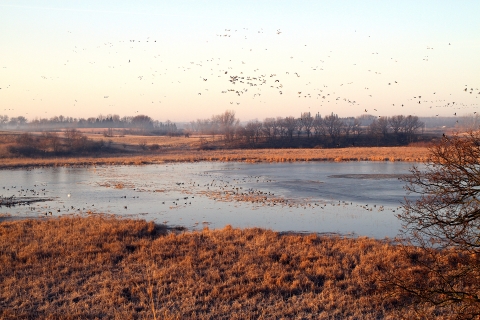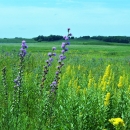About Us
Windom Wetland Management District was established in 1990 for the purpose of increasing waterfowl production and to preserve habitat for migratory birds, threatened and endangered native species and resident wildlife. The district manages approximately 17,000 acres of federal owned waterfowl production areas across a 13 county area in southern Minnesota - lands dedicated to wildlife and wildlife-dependent recreation.
Since 2000, the district has also been acquiring and managing roughly 1,500 acres of remnant native prairie tracts as a part of the Northern Tallgrass Prairie National Wildlife Refuge. These tracts provide critical habitat for grassland birds, such as meadowlark and bobolink, as well as a variety of mammals, reptiles, amphibians and other creatures. In addition, the district oversees thousands of acres of privately-owned wetland and grassland habitat, purchased as permanent easements.
Windom Wetland Management District staff also administer the U.S. Fish and Wildlife Service Partners for Fish and Wildlife program, which provides technical and financial assistance to restore or improve wildlife habitat on private land.
If you are interested in improving wildlife habitat on your property in southwest Minnesota, contact our Private Lands Biologist, Scott Ralston at (507) 831-2220.
Our Mission
The mission of the National Wildlife Refuge System is to administer a national network of lands and waters for the conservation, management and, where appropriate, restoration of the fish, wildlife and plant resources and their habitats within the United States for the benefit of present and future generations of Americans.
Every national wildlife refuge national wildlife refuge
A national wildlife refuge is typically a contiguous area of land and water managed by the U.S. Fish and Wildlife Service for the conservation and, where appropriate, restoration of fish, wildlife and plant resources and their habitats for the benefit of present and future generations of Americans.
Learn more about national wildlife refuge and wetland management district wetland management district
A wetland management district is a U.S. Fish and Wildlife Service office that manages waterfowl production areas in one or more counties. Waterfowl production areas are small natural wetlands and grasslands that provide breeding, resting and nesting habitat for waterfowl, shorebirds, grassland birds and other wildlife. The Fish and Wildlife Service acquires waterfowl production areas under the authority of the Migratory Bird Hunting and Conservation Stamp Act, primarily using funds from the sale of Federal Duck Stamps. The Refuge System’s 38 wetland management districts comprise thousands of waterfowl production areas – almost all in the Prairie Pothole Region of the Northern Great Plains.
Learn more about wetland management district was created for a special purpose. Some were created to protect migratory birds, others to protect threatened or endangered species or unique habitats, while others fulfill another special purpose. All activities allowed on refuges must be evaluated to make sure each activity will not conflict with the reason the refuge was founded.
The purpose of Windom Wetland Management District is to serve as a refuge and breeding ground for migratory birds and other wildlife.
Our History
1934 - The Migratory Bird Hunting and Conservation Stamp Act was created. Commonly referred to as the "Duck Stamp Act" this law requires each waterfowl hunter 16 years of age or older to possess a valid Federal hunting stamp. The receipts from the sale of the stamp are deposited in a special Treasury account known as the Migratory Bird Conservation Fund and are not subject to appropriations.
1958 - Congress officially created the Small Wetland Acquisition Program by amending the 1934 Migratory Bird Hunting and Conservation Stamp Act to allow proceeds from the sale of Federal Duck Stamps to be used to protect waterfowl habitat.
1990 - Windom Wetland Management District was established to provide migratory and breeding habitat for waterfowl and other migratory birds
2001 - The Loosbrock Unit was purchased in Rock County as the first fee-title tract of the Northern Tallgrass Prairie National Wildlife Refuge .
Other Facilities in this Complex
Windom WMD also manages five tracts of the Northern Tallgrass Prairie NWR.

